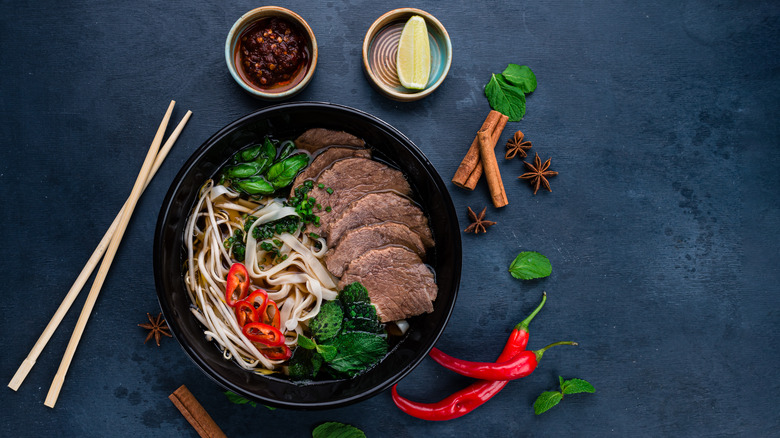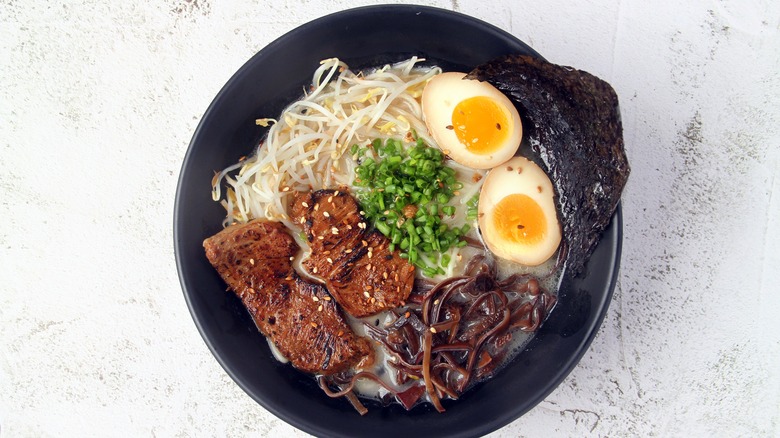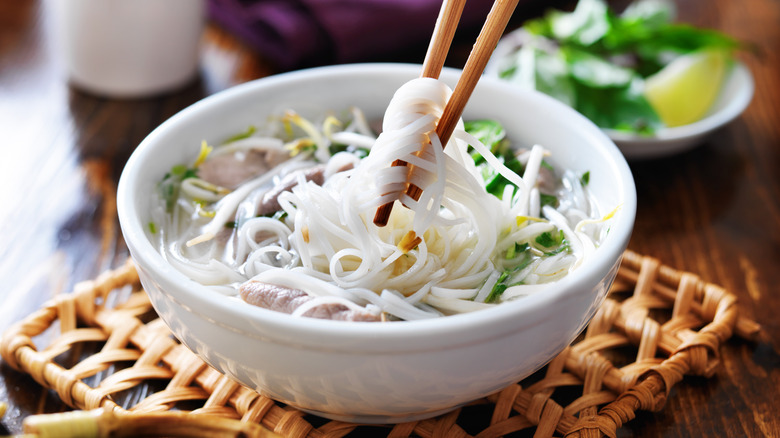Ramen Vs. Pho: What Makes The Soups So Different?
We may receive a commission on purchases made from links.
While ramen and pho are both Asian noodles in broth, the dishes' flavors couldn't be more different, given that ramen is a Japanese dish (by way of China) while pho (pronounced "fuh") is a Vietnamese dish. These noodle dishes differ quite a bit in terms of ingredients, flavor, and preparation. Still, if you are more familiar with the instant ramen version and are suddenly given a few unlabeled bowls of noodles and asked to identify which is pho and ramen, it is understandable if you hesitated for a few minutes.
As a general rule, the variation for ramen comes from the broth seasoning while the variation for pho comes from the toppings. If that rule is too generic, below is a more detailed guide starting with components that can be difficult to differentiate (broth) and working towards the components that are a giveaway (noodles, toppings). The result of either is a delicious and comforting culinary experience.
Ramen broth is hearty while pho broth is light
The base for ramen broth is often made from simmered pork or chicken bones, but according to Masterclass, among the seven types of ramen, even seafood-based broths can be used. The various broths can be flavored with either miso (fermented soy paste), shio (salt) or shoyu (soy sauce). When the pork bones are simmered for longer, it becomes tonkotsu, which is thicker and richer compared to the rest. The color of the broth runs from clear to cloudy or brown, depending on the type of seasoning.
The broth for pho is more standardized (albeit with some regional variations in Vietnam). It is typically made by slowly simmering beef bones for about 12 hours, per Food Network, but chicken or vegetable broths are also options. The broth incorporates whole spices like cinnamon, star anise, and peppercorns. The broth is clear and light because one of the steps in making the broth is to periodically remove the scum and impurities that rise to the top when boiling the meat and bones. The emphasis on clear broth is also why people prefer to use whole spices that can be strained, rather than ground spices which will cloud the color of the broth. Later proteins and toppings are added to the steaming broth.
Because of the difference in ingredients and preparation, ramen broth is more hearty and savory while pho broth is lighter, aromatic, and fragrant.
The toppings for ramen and pho are almost mutually exclusive
Besides the broths, the noodles are different in pho and ramen too. Ramen uses wheat-based noodles which are thick and chewy. The toppings are indicative of the dishes' Japanese origin as it typically includes sliced meat, soft-boiled eggs, scallions, and seaweed.
Pho, on the other hand, has rice noodles that are comparatively thin, translucent, and delicate. The variations in pho are evident in the toppings, which can include different cuts of thinly sliced meat. A popular choice is thinly sliced raw beef (which cooks to medium rare in the broth), bean sprouts, Thai basil, cilantro, and lime. The last three ingredients usually come separately so diners can add them to taste. Notice that pho does not come with egg, unlike ramen.
The additional topping for pho can also be sliced red chile or Sriracha, depending on one's preferences. This is an important point to note because a few years ago, readers were outraged when a chef told Bon Appétit that "adding Sriracha or hoisin sauce destroys the (pho) broth's flavor." We have all learned from this and the takeaway is, there is no "right" way to cook or eat noodles. It boils down (no pun intended) to individual taste and what is left in our pantries.


